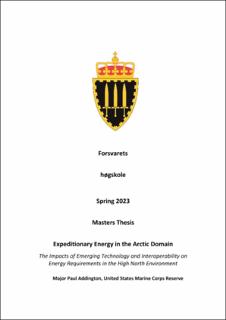| dc.description.abstract | The primary objective of this paper is to explore the current status of electrical energy generation in the Arctic environment and identify possible materiel or interoperability solutions to increase the electrical energy self-sufficiency of tactical-size military units conducting distributed operations in the Norwegian High North. This exploration is undertaken by establishing a knowledge baseline of the Norwegian High North's political, geographical, military, and social considerations. Next, a model of explanation will be introduced using the NATO DOTMILPF-I framework to examine the problem statement. This is followed by examining current Marine Corps electrical energy generation solutions using recent training and exploring emerging technologies that could be used to increase tactical-size unit electrical energy self-sufficiency. The emerging technologies will focus primarily on using hydrogen as an energy carrier; however, other applications will also be considered. The research method and design will be supported by a focused literature review from Marine Corps expeditionary energy solutions sources and content analysis of existing data related to Marine Corps training in Northern Norway from 2018 – April 2023. These methods are augmented by my first-hand observations experienced during this period while supporting Marine Corps training in Norway from 2017 to the present. The Marine Corps emerging doctrinal concepts summarized and linked to the problem statement include A Concept for Stand-in Forces, A Functional Concept for Maritime Reconnaissance and Counter-reconnaissance, and Expeditionary Advance Base Operations. The empirical analysis will be focused by using the NATO DOTMILPF-I framework with the training, materiel, and interoperability elements selected as the most applicable for exploring this problem statement. Existing interoperability relationships will be explored to identify current relationships and future partnership opportunities between units or research organizations. Finally, key findings will be discussed and recommendations given on addressing this thesis's problem statement. In summary, this paper will provide an understanding of the current Arctic environment and military considerations related to military operations in the Norwegian High North, connect the emerging Marine Corps doctrinal concepts with electrical energy self-sufficiency considerations, and link these considerations to future interoperability between the Norwegian Armed Forces and the United States Marine Corps. Lastly, while the scope of this problem statement will be limited to the Norwegian High North, electrical energy self-sufficiency considerations have the potential for global Marine Corps utilization. | en_US |
